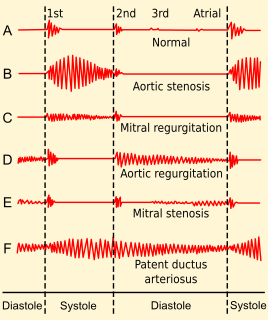
Endocarditis is an inflammation of the inner layer of the heart, the endocardium. It usually involves the heart valves. Other structures that may be involved include the interventricular septum, the chordae tendineae, the mural endocardium, or the surfaces of intracardiac devices. Endocarditis is characterized by lesions, known as vegetations, which is a mass of platelets, fibrin, microcolonies of microorganisms, and scant inflammatory cells. In the subacute form of infective endocarditis, the vegetation may also include a center of granulomatous tissue, which may fibrose or calcify.

Pasteurellosis is an infection with a species of the bacterial genus Pasteurella, which is found in humans and other animals.
The HACEK organisms are a group of fastidious Gram-negative bacteria that are an unusual cause of infective endocarditis, which is an inflammation of the heart due to bacterial infection. HACEK is an abbreviation of the initials of the genera of this group of bacteria: Haemophilus, Aggregatibacter, Cardiobacterium, Eikenella, Kingella. The HACEK organisms are a normal part of the human microbiota, living in the oral-pharyngeal region.

Mitral valve prolapse (MVP) is a valvular heart disease characterized by the displacement of an abnormally thickened mitral valve leaflet into the left atrium during systole. It is the primary form of myxomatous degeneration of the valve. There are various types of MVP, broadly classified as classic and nonclassic. In severe cases of classic MVP, complications include mitral regurgitation, infective endocarditis, congestive heart failure, and, in rare circumstances, cardiac arrest.

Infective endocarditis is an infection of the inner surface of the heart, usually the valves. Signs and symptoms may include fever, small areas of bleeding into the skin, heart murmur, feeling tired, and low red blood cell count. Complications may include backward blood flow in the heart, heart failure – the heart struggling to pump a sufficient amount of blood to meet the body's needs, abnormal electrical conduction in the heart, stroke, and kidney failure.

Aortic regurgitation (AR), also known as aortic insufficiency (AI), is the leaking of the aortic valve of the heart that causes blood to flow in the reverse direction during ventricular diastole, from the aorta into the left ventricle. As a consequence, the cardiac muscle is forced to work harder than normal.
Libman–Sacks endocarditis (LSE) is a form of non-bacterial endocarditis that is seen in association with systemic lupus erythematosus (SLE), antiphospholipid syndrome, and malignancies. It is one of the most common heart-related manifestations of lupus.

Valvular heart disease is any cardiovascular disease process involving one or more of the four valves of the heart. These conditions occur largely as a consequence of aging, but may also be the result of congenital (inborn) abnormalities or specific disease or physiologic processes including rheumatic heart disease and pregnancy.
Bartonella quintana, originally known as Rochalimaea quintana, and "Rickettsia quintana", is a bacterium transmitted by the human body louse that causes trench fever. This bacterial species caused outbreaks of trench fever affecting 1 million soldiers in Europe during World War I.
Pasteurella canis is a Gram-negative, nonmotile, penicillin-sensitive coccobacillus of the family Pasteurellaceae. Bacteria from this family cause zoonotic infections in humans, which manifest themselves as skin or soft-tissue infections after an animal bite. It has been known to cause serious disease in immunocompromised patients.
Actinobacillus rossii is a bacterium. It was first isolated from the vaginas of postparturient sows.
Cricetibacter is a genus of bacteria from the family of Pasteurellaceae with one known species. Cricetibacter osteomyelitidis has been isolated from a European hamster with osteomyelitis.
Frederiksenia is a genus of bacteria from the family of Pasteurellaceae with one known species. Frederiksenia canicola has been isolated from the pharynx of a dog.
Mesocricetibacter is a genus of bacteria from the family of Pasteurellaceae with one known species. Mesocricetibacter intestinalis has been isolated from the caecitis of the hamster.
Muribacter is a genus of bacteria from the class of Pasteurellaceae with one known species. Muribacter muris has been isolated from a mouse.
Necropsobacter is a Gram-negative and non-motile genus of bacteria from the family of Pasteurellaceae.
Otariodibacter is a genus of bacteria from the class of Pasteurellaceae with one known species. Otariodibacter oris has been isolated from an oral swab from a Californian sea lion from the Copenhagen Zoo in Denmark.
Actinobacillus equuli is a gram-negative, non-motile rod bacteria from the family Pasteurellaceae.
Riemerella columbipharyngis is a bacterium from the genus of Riemerella which has been isolated from the pharynx of a domestic pigeon.
Ornithobacterium is a genus of Gram-negative, microaerophilic, rod-shaped bacteria from the family Weeksellaceae. It comprises two known species, O. hominis and O. rhinotracheale. Both species inhabit the respiratory tract: O. hominis is found in the human nasopharynx and O. rhinotracheale in the trachea of wild and domesticated birds





